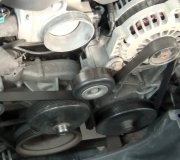I can't recover anything financially even if it was a possible cause as the complex has since been sold to another owner and too much time passed. The manager of the complex who has been here for 15 + yrs. Has a Toyota Camry that strangely has also had to have not one, but two emergency timing belt replacements on her car. The first one also had to be done at 50,000 miles or less. I am not certain how many miles she now has on it or what year it is but it isn't that old. I have not brought this question up to her at all since she works for the complex.
I just really wonder if there could possibly be any relationship to those ridiculously high speed bumps of the past. They are within normal height limits now but they still have huge chunks of asphalt and yellow paint missing from some of the really low vehicles especially when they are loaded down with household belongings, furniture, etc. When people are moving. I do know that there will always be the people who race over them and scrape the bottom because they are inconsiderate morons.
I have now come to find out that there are other options in speed bumps that can inflate higher if the speed of the approaching vehicles is too great. They also do not have one sign posted about the fact that there are multiple school bus stops and young children and disabled people. There is not even one camera in any part of the very large parking lot. Some of those options are probably more costly then they would be willing to spend but for heavens sake they certainly could put in a couple of signs.
If you can answer that question I would sure appreciate it. Thank you so much. Please don't give or sell my name & e-mail to people.
SPONSORED LINKS
Sunday, July 5th, 2015 AT 4:42 PM



